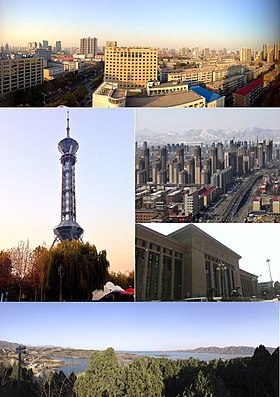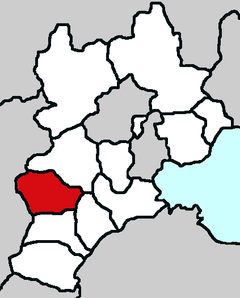Shijiazhuang
| Shijiazhuang Shi 石家庄 市 Shijiazhuang |
||
|---|---|---|
 Scenes from Shijiazhuang |
||
|
|
||
| Coordinates | 38 ° 3 ' N , 114 ° 30' E | |
 Shijiazhuang (red) in Hebei (white) |
||
| Basic data | ||
| Country | People's Republic of China | |
| region | North china | |
| province | Hebei | |
| ISO 3166-2 | CN-HE | |
| status | District-free city | |
| structure | 8 city districts, 11 districts, 2 independent cities | |
| height | 83 m | |
| surface | 13,504 km² | |
| Residents | 10,900,000 (end of 2017) | |
| density | 807.2 Ew. / km² | |
| Post Code | 050000 | |
| Telephone code | +86 (0) 311 | |
| Time zone | China Standard Time ( UTC + 8 ) | |
| Website | www.sjz.gov.cn | |
| politics | ||
| mayor | Ai Wenli | |
Shijiazhuang ( Chinese 石家莊 市 / 石家庄 市 , Pinyin Shíjiāzhuāng Shi ) is the capital of Hebei Province in the People's Republic of China . The administrative area of the prefecture -level city has an area of 13,504 km² (does not include the 960 km² of the city of Xinji , which is administered by the province). As of the end of 2017, Shijiazhuang had a resident population of around 10.9 million people. 3.1 million people live in the actual urban settlement area of Shijiazhuang (2010 census).
Administrative structure
At the county level, Shijiazhuang consists of eight boroughs , eleven counties and two independent cities. These are:
- City districts Chang'an (长安区, seat of the city government), Qiaoxi (桥西 区), Xinhua (新华 区), Yuhua (裕华 区), Jingxingkuang (井陉 矿区), Gaocheng (藁城市), Luquan (鹿泉 市) , Luancheng (栾城县),
- Districts Jingxing (井陉县), Zhengding (正定 县), Xingtang (行 唐县), Lingshou (灵寿县), Gaoyi (高邑 县), Shenze (深泽县), Zanhuang (赞皇县), Wuji (无极 县), Pingshan (平山县), Yuanshi (元氏 县), Zhao (赵县),
- Independent cities of Jinzhou (晋 州市) and Xinle (新 乐 市).
Since June 1, 2013, the county-level city of Xinji (辛集 市) has been administered directly by Hebei Province. With the territorial reform of September 9, 2014, the Qiaodong District was dissolved, and Luancheng, Luquan, and Gaocheng became districts.
population
As of the end of 2017, Shijiazhuang had a resident population of 10,879,900 and a registered population of 9,732,900. 4,456,118 people were registered as urban residents and 5,276,784 rural residents. At the end of 2017, the 8 districts that make up the actual urban area had a registered population of 4,168,700, of which 3,071,559 were registered as urban populations.
Population growth was 1.34% compared to 2016. Of this, 0.78% is due to natural population growth , the rest is due to people moving into the city.
Of the registered population, 50.26% are men and 49.74% are women.
As of the end of 2017, members of 51 ethnic groups were registered in Shijiazhuang . The Han Chinese accounted for 98.82%, the Hui Chinese 0.61%, the Manchurians 0.38%, and all other groups 0.19%.
economy
According to a study from 2014, Shijiazhuang has a gross domestic product of 130.5 billion US dollars in purchasing power parity . In the ranking of the economically strongest metropolitan regions worldwide, the city took 100th place. The GDP per capita is $ 12,405 (PPP). The city employed 1.4 million people. At 9.1% annually in the period from 2009 to 2014, GDP per capita grew rapidly.
Others
The city was founded in 1925 , formally declared a city on October 7, 1939 , then under the name Shímén (石門). On December 26, 1947 , the city was renamed Shijiazhuang. Xibaipo - an important site of the Chinese revolution - was the seat of the headquarters of the Central Committee of the Communist Party of China during the War of Liberation.
The approximately 270 km long highway, which connects Shijiazhuang with Beijing , was built between 1986 and 1993 and was the first major Chinese highway project. On January 1st, 1989, there were 147 km of highways in the whole of China; today, an average of 5,000 km of new routes are completed in the country every year.
As in all major cities in China, air pollution is a major problem. In December 2016, Shijiazhuang was considered the most polluted city in all of China or even the world for over a month with a persistent dense bell of smog.
Town twinning
-
 Nagano , Japan , since 1981
Nagano , Japan , since 1981 -
 Saskatoon , Canada , since 1985
Saskatoon , Canada , since 1985 -
 Des Moines , United States , since 1985
Des Moines , United States , since 1985 -
 Parma , Italy , since 1987
Parma , Italy , since 1987 -
 Corby , United Kingdom , since 1994
Corby , United Kingdom , since 1994 -
 Cheonan , South Korea , since 1997
Cheonan , South Korea , since 1997 -
 Santiago de Querétaro , Mexico , since 1997
Santiago de Querétaro , Mexico , since 1997 -
 Falkenberg , Sweden , since 2002
Falkenberg , Sweden , since 2002 -
 Nam Định , Vietnam , since 2004
Nam Định , Vietnam , since 2004
Climate table
| Shijiazhuang | ||||||||||||||||||||||||||||||||||||||||||||||||
|---|---|---|---|---|---|---|---|---|---|---|---|---|---|---|---|---|---|---|---|---|---|---|---|---|---|---|---|---|---|---|---|---|---|---|---|---|---|---|---|---|---|---|---|---|---|---|---|---|
| Climate diagram | ||||||||||||||||||||||||||||||||||||||||||||||||
| ||||||||||||||||||||||||||||||||||||||||||||||||
|
Average monthly temperatures and rainfall for Shijiazhuang
|
|||||||||||||||||||||||||||||||||||||||||||||||||||||||||||||||||||||||||||||||||||||||||||||||||||||||||
Buildings
Web links
Individual evidence
- ↑ 市 情 概览> 自然地理.石家庄 市 人民政府 办公室, October 30, 2018, accessed June 4, 2019 (Chinese).
- ↑ a b c d e 市 情 概览> 人口 状况.石家庄 市 人民政府 办公室, October 29, 2018, accessed on June 4, 2019 (Chinese).
- ↑ Hebei (China): Prefecture Level, Cities & Counties - Population Statistics, Maps, Graphics, Weather and Web Information. Retrieved January 17, 2018 .
- ↑ a b 市 情 概览> 行政 区划.石家庄 市 人民政府 办公室, October 25, 2018, accessed on June 4, 2019 (Chinese).
- ^ Alan Berube, Jesus Leal Trujillo, Tao Ran, and Joseph Parilla: Global Metro Monitor . In: Brookings . January 22, 2015 ( brookings.edu [accessed July 30, 2018]).
- ^ Life inside China's most polluted city. BBC News, January 6, 2017, accessed November 22, 2017 .

